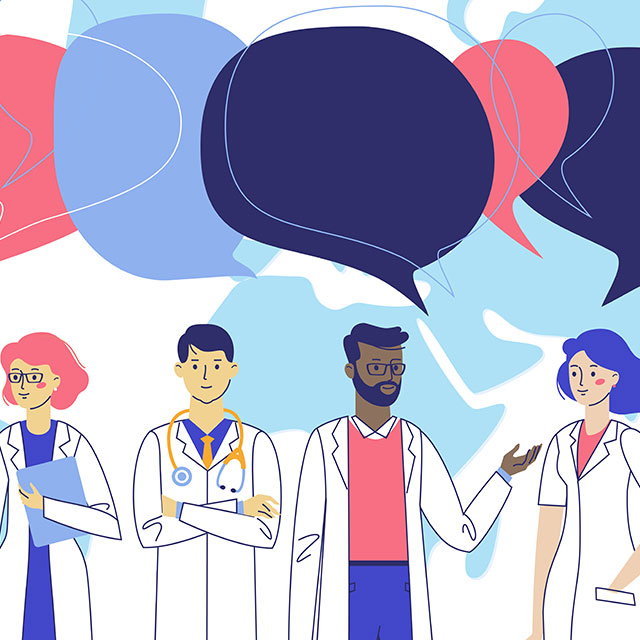Johns Hopkins clinicians are finding that improved access to medical interpreters, now available through an app on their mobile phones, is helping to expedite and improve the care they give to patients who do not speak English as their primary language.
“I love the service and recently was able to download the CyraCom interpreter app on my phone, which I now use almost every shift,” says Stephanie Figueroa, physician assistant manager in the emergency medicine department.
The technology is also available to clinicians throughout the hospital to obtain a general history from patients who do not speak English as their primary language or who have a limited ability to read, speak, write, understand or hear it.
Tina Tolson, senior director of operations for Johns Hopkins Medicine Language Services, says the following interpretation services for patient and family communications are available 24/7 for Johns Hopkins staff.
- Over the phone/audio only interpretation uses the phone or other audio functionality through the app to connect the patient and a staff member to a qualified medical interpreter.
- Video remote interpretation uses an app through an iPad or other mobile electronic device to connect patients and practitioners with qualified medical interpretation through real-time video transmission. This feature is particularly important for sign language.
- For in-person interpretation, a qualified medical interpreter goes to the patient’s hospital room or a medical office to interpret for the patient and the clinical team. This service is mostly reserved for highly complex patient conversations or acute situations.
In addition to these services, Johns Hopkins can qualify bilingual staff members to use their language skills for medical conversations within their role and department. This program aims to ensure safe, effective communication in every patient interaction by training and qualifying practitioners and staff members at the following levels:
- Qualified bilingual staff interpreters have the linguistic skills and understanding of medical terminology and concepts that allow them to interpret between staff members and patients within their clinical setting and professional role.
- Qualified bilingual staff speakers can, within their clinical setting and professional role, use their language skills for direct conversations between themselves and patients or family members. However, they cannot serve as interpreters, or assist two or more people in communicating with one another. Qualified bilingual staff interpreters or professional medical interpreters, who are held to higher industry standards and expectations, must perform this work.
The benefits of using these approved interpretation services, according to several studies, include lessening the length of time that patients stay in the hospital and in the emergency department, as well as reducing their 30-day readmission rate.
Without such services, adverse events in the hospital are likely to be more severe for patients with limited English proficiency due to communication errors. This risk has been further demonstrated during the COVID-19 pandemic. With the number of in-person interpreters limited in order to minimize spread of the virus, alternative modalities to promote effective communication with patients became even more critical.
Tolson says the crisis accelerated efforts to centralize patient communication services across the system, and to expand the numbers of qualified bilingual staff members as well as improve access to audio and video interpretation resources. In-person interpreters remain available, but they are prioritized for more critical or complex conversations. Now, using the interpretation app, practitioners can reach an interpreter who speaks one of 240 languages in less than a minute, often making interpretation easier and more efficient.
Joseph Perno, emergency medicine physician and vice president of medical affairs at Johns Hopkins All Children’s Hospital (JHACH), says using the app on his phone is very helpful, and he appreciates the ease of having “an interpreter in his pocket.” He says finding the shared departmental iPad often means searching to determine if it is being used or if it was mistakenly left in a patient’s room.
“Now, if I walk into a patient’s room and suddenly learn I need interpretation, no problem,” Perno says. “I can just call it up on my phone.”
About 5% of patients in the Johns Hopkins system only or primarily speak a language other than English. Perno says the most requested language at JHACH is Spanish. This is also true at The Johns Hopkins Hospital. After Spanish, the most requested languages in order of their use in 2022 were Chinese (Mandarin), Korean, Arabic, American Sign Language, Russian, Vietnamese and Romanian.
Documenting Use of Language Services
Tolson says that in order to comply with Johns Hopkins policy and with legal and regulatory guidance, practitioners and staff members must document use of interpreters and/or auxiliary aids for all pertinent medical discussions.
This is especially important on consent forms.
Practitioners and staff members should document the patient’s and/or the patient contact’s preferred language for medical discussions in the demographics field in Epic. Carried throughout the medical record, this helps identify and reinforce when an interpreter should be used.
Contact information for interpreter services:
[email protected] for general questions
[email protected] or 410-614-4685 for interpretation requests, para español 1-844-765-9930
[email protected] for written translation requests


